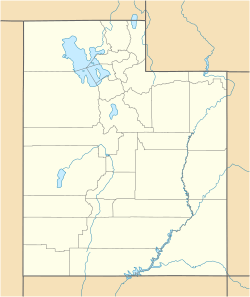McCornick, Utah facts for kids
Quick facts for kids
McCornick
|
|
|---|---|
| Country | United States |
| State | Utah |
| County | Millard |
| Established | 1919 |
| Abandoned | 1930 |
| Named for | William McCornick |
| Elevation | 4,747 ft (1,447 m) |
| GNIS feature ID | 1455891 |
McCornick is a place in Millard County, Utah, United States. It's known as an unincorporated community, meaning it's not officially a town or city with its own local government. It's also almost a ghost town.
McCornick is located about 11 miles (18 km) northwest of Holden. It was started in 1919 as a farming project but didn't last long. By 1930, most people had left. Today, you can still find a few scattered homes and farms there.
Contents
A Short History of McCornick
In 1918, a company called the Sevier River Land and Water Company had a big idea. They wanted to help people farm in a new area. They had already done well near Lynndyl. Now, they wanted to expand their water project further south.
Building the Water System
The company built a special water channel called an aqueduct. This channel carried water from Leamington. It ran along the hills of the Canyon Mountains. The goal was to bring water to huge areas of land that could be good for farming. This process is called irrigation.
People who strongly promoted the project, sometimes called "boosters," started to attract new settlers. They used fancy ads and strong sales talks. They told people how easy it would be to farm near Delta. Delta had a large sugar factory and a main train line. They also said the water supply was excellent, better than it had been in years.
Early Days and Challenges
Many families and single people arrived in early 1919. They started farming right away. But in May 1919, the main water channel broke. This caused floods on about 15 farms near Whiskey Creek.
Even with the flood damage, there was plenty of water that year. Most farmers had great harvests. This helped them build about 40 strong, permanent homes.
The next year, the water channel broke again. Some families decided to leave the area completely. But news of the town's success still brought new settlers. In 1920, McCornick began to look like a real town.
Growth of the Community
The Church of Jesus Christ of Latter-day Saints built a church building. They also organized a local group called a "ward" with 83 families. A small post office was set up. The town was named after William McCornick. He was a banker from Salt Lake City and helped promote the water company.
A schoolhouse and a general store were also built. McCornick's population reached its highest point in 1921, with about 500 people living there.
The Decline of McCornick
The town's luck changed in the winter of 1921–1922. It was the driest winter in many years. After that, there were more dry years, lots of grasshoppers, and big dust storms.
McCornick had been promised too much. The water supply for farming was not enough. Developers had said they could water 200,000 acres (81,000 ha) of land. But by 1922, they couldn't even water 1,000 acres (400 ha). The wet years from 1917 to 1921 were unusual. The area was returning to its normal desert state.
By 1923, only 50 families were left in town. In 1926, the Sevier River Land and Water Company went out of business. It was sold to a company from California and renamed the Central Utah Water Company. But this change didn't stop people from leaving.
By 1929, only four or five families remained. McCornick had 95 births and 10 deaths during its short time. Many of its buildings were moved to other towns. For example, the schoolhouse was taken to Flowell in 1930. Today, only two or three of the old houses are still standing. The land is mostly used for grazing animals and growing hay.



